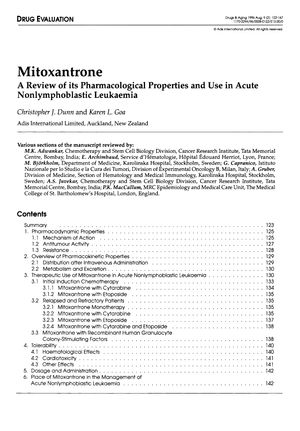Mitoxantrone
August 1996
in “
Drugs & Aging
”

TLDR Mitoxantrone is effective for treating acute leukemia, especially in older patients, with a lower risk of heart damage.
In 1996, mitoxantrone was reviewed for its use in treating acute nonlymphoblastic leukemia (ANLL), particularly in older patients. The drug, often combined with cytarabine, showed complete response rates of 53 to 67% in untreated ANLL and was effective in relapsed or refractory cases. Mitoxantrone's cardiotoxicity was lower than that of anthracyclines, making it suitable for elderly patients. It works by interfering with topoisomerase II and inducing apoptosis in leukemia cells. Pharmacokinetic studies revealed a large volume of distribution, liver metabolism, and biliary elimination. Various studies reported complete response rates ranging from 16 to 83% when mitoxantrone was used with other agents, and a Japanese study showed a 57% complete remission rate with G-CSF following mitoxantrone therapy. Despite its effectiveness, the prognosis for older ANLL patients remains poor, with high early death rates. Mitoxantrone is recommended at a dosage of 12 mg/m² daily for three days with cytarabine and is considered suitable for first-line therapy in ANLL patients of all ages.